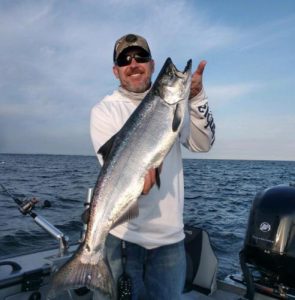The King of Lake Ontario
It’s that time of year again here in Western New York when His Excellency the King Salmon, formally known as the chinook salmon, moves in from the bowels of Lake Ontario to play with average anglers. These silver torpedoes spend most of their summer out in the middle of our Great Lake where only the fully geared and tricked out anglers can produce them consistently and, judging by the fantastic year these boats are having out deep, it should be a record breaking fall for the anglers on the piers and tributaries.

Come about the time the Bills complete training camp at St. John Fisher, the kings start their migration from the deep to the tributaries where they were stocked. Then by the end of August it is “game on” for any angler who wants to take them on.
Kings spawn in the fall, with peak activity occurring from mid-October to mid-November. Although some spawning does occur near river mouths, most spawning takes place in upstream sections of rivers or streams. Adult salmon build nests called “redds” in the stream bottom. The redds are dug by the female in areas of moving water, such as near riffles or at the tail end of pools. The female moves gravel and small rocks with vigorous sweeps of her tail until a depression has been created. The eggs are then deposited and quickly fertilized.
Salmon protect their eggs by burying them in gravel. After spawning, the female moves upstream a short distance and digs into the gravel, freeing it so it will drift downstream and cover the eggs. Buried under layers of gravel, the salmon embryos develop slowly and hatch in late winter or early spring. After hatching, young salmon move downstream into Lake Ontario.
King salmon can exceed 100 pounds on the Pacific coast. Here in New York state, the record fish is a 47 pounder caught in Lake Ontario. Salmon have a limited distribution in New York state and are only found in Lakes Erie and Ontario. Non-natives of New York state, chinooks were first stocked into the Great Lakes in 1873. Although they were sporadically stocked throughout the years, it was not until about 20 years ago that they became abundant. At that time, New York State aggressively stocked kings into Lakes Erie and Ontario to provide a sport fishery. Using the tremendous population of alewives at that time as a food source, chinooks thrived and produced a spectacular fishery. Since there is not enough suitable spawning and nursery area to naturally produce enough fish, most of the salmon caught in New York state’s Great Lakes are now hatchery-reared.
While adult king salmon spend most of their time in deeper, open water, they will follow prey fish into near shore areas in early spring, late summer or early fall. Sexually mature chinooks stage around the mouths of streams in the fall in preparation for making their spawning runs. September normally marks the arrival of the earliest run of fish into lake tributaries, and peak runs occur in October. Spawning is completed by early November and the adult salmon die shortly thereafter.
Once in the rivers, kings may be taken using a variety of angling techniques. Salmon egg sacs, flashy spoons, or deep diving plugs are effective in the lower river portions; while egg sacs and other egg imitations, including artificial flies, are good in faster upstream water areas. Major Lake Ontario tributaries having kings runs include the Salmon River, Oswego River, Genesee River, Oak Orchard Creek and Eighteen Mile Creek.
Local Charter Captain Jeremy Sage points out, “The first sign that chinooks are beginning their migration to spawn is the color of their skin; it darkens through to a green olive color and eventually will be a dark brown once they are at the dams up the river. When fishing tight to shore run J-plugs and stick baits. These baits dive only 3 to 5 feet, allowing you to run them by themselves, or flat lined off the side of your boat. These are wobbly baits that usually glow or are chrome in color and have a pretty erratic side-to-side action which spawning salmon can’t resist. Don’t be afraid to change things up: speed, lure colors, direction of your troll.”
Jeremy goes on to say, “Come September you can find these salmon right outside the piers and breakwalls of your nearby tributaries. Once the kings make it in to shallow water you can go out there in any kind of boat that is safe for the conditions and catch yourself a 20 lb. plus fish.
“Planer boards can help spread your lines. I deploy them, 30 to 75 feet, and attach an inline planer board. Oftentimes fish will hold in one area for a few hours. It is very important to turn back and go right back through where you just caught a fish.
“Boat speed is very important based on what lures you have in the water. Typically, I keep my lures running at 2.4 to 2.8 mph down speed. That speed is taken off a temperature/speed device that I run off of my downriggers. It is very important to make sure your lures are running at the correct speed where the fish are, versus how fast your boat is moving. Sometimes these two variables differ big time, making this the most important tool that I own, other than my boat.”
Thanks again to Jeremy for passing on his hard-earned tips. If you don’t have a boat and want to tangle with the king, contact Jeremy at JD Custom Charters (jdscustomcharters.com), Jeremy Sage’s Facebook page, or by phone at 585-734-8930.
If ever there was a year to try this big game fishing this is it; so, get off the couch and go wrestle a king.




